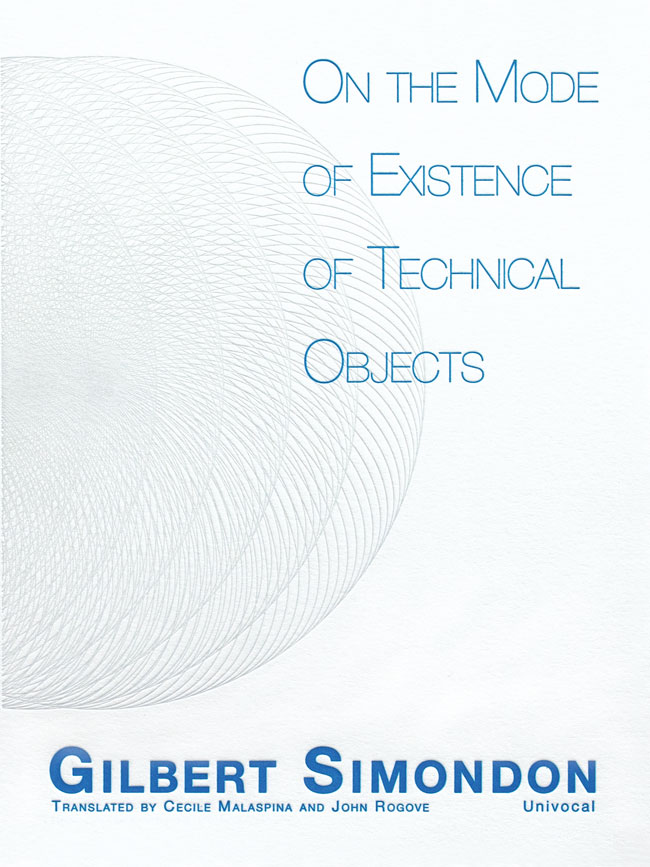a review of Gilbert Simondon, On the Mode of Existence of Technical Objects (University of Minnesota Press, 2016)
by Justin Raden
In a recently translated interview, Bernard Stiegler makes a strong appeal for an unlikely partnership between technical knowledges and philosophy. Stiegler chides and ventriloquizes “academic philosophy” for its proud negligence when it comes to technical knowledge. “As if,” he says, “we could ever feel proud of not understanding how a system functions.” He continues: “How can we claim to understand anything about Hegel if we do not feel capable of understanding the functioning of a diode? Hegel, who himself wrote on electricity, would have undoubtedly found this ludicrous.”[i] Such an appeal is typical of Stiegler, whose opus, the three-volume Technics and Time, begins by claiming that the history of philosophy is the history of the suppression of technics. But what do diodes have to offer philosophy or any discipline outside of electrical engineering? How is it, exactly, that no reading of Hegel can reasonably avoid a prerequisite course of study in circuit diagrams?
Stiegler’s polemic points in two directions: at a misrecognition in the contemporary discourse about our own technological landscape, and at an inability to discover in the history of philosophy precursors to this discourse. In the 1990s, when Stiegler’s work first appeared, critical and social theory in the Anglo-American scene was little interested in emerging frameworks for conceiving of changes in the social fabric. Mark Poster complained that in spite of “alternative rubrics” like “postindustrial society, information society, the third wave, the atomic or nuclear or electronic age” we continued to rely on the perceived power of old explanatory models.[ii] In the meantime, the intellectual scene Poster bemoaned has been replaced with a fervor of interdisciplinary activity in which a number of fields in the humanities have rushed to upgrade the critical apparatus by adopting epistemological and methodological frameworks from elsewhere. The most notable in the field of literary studies are the appropriations of aspects of Latourian “science studies” and the computational and media theory that has coalesced into the ambiguously circumscribed discipline of digital humanities. And yet Stiegler’s early work, while it might appear as a radical innovation in philosophical thought, is partly premised on a return to a lesser known French thinker whose work problematizes both of these disciplinary orientations: Gilbert Simondon. Indeed, Simondon (and Stiegler in turn) troubles the logics which partition and predicate the newness of the new and the oldness of the old.
The long overdue English translation of Simondon’s Du mode d’existence des objets techniques (On the Mode of Existence of Technical Objects), originally published in 1958, provides an opportunity to reflect on the protean terrain of the human sciences as they struggle to account for ever more rapid technological change and its relation to ecological, economic, and political crises. Simondon’s interventions are manifold and the consequences of these are only just beginning to be appreciated and interrogated for their contemporary relevance. His principal objective is the reintegration of the philosophy of technology with philosophy in general, or more exactly with culture in general. This as yet unrealized ambition produced, for Simondon, a social imaginary of technology that, if anything, is more entrenched today: the mythologizing of robotics, the errant belief that automatism signals the highest level of technical development, the experience of alienation as non-knowledge of the machine.
Tracing the disaggregation of techne or technics (or sometimes “the mechanical arts”) from what he calls “noble thought” or “the noble arts” back to ancient Greece, Simondon describes the consequences of this division through the twentieth century. Doing so allows him to provide a corrective to a mode of thought that cannot think the intervention of the technical object “as mediator between man and the world” (183) in the sense that it directs or determines the form of the detachment from the prior unity into nature and culture. The division of thought as Simondon describes it originally occurs because of a devaluation of technics––especially technics that employed tools––due to its association with slavery. This process is then periodically reduplicated: “there is, in each epoch, a part of the technical world that is recognized by culture, while other parts of the technical world are rejected” (104). As a result of this series of expurgations, we become, beginning especially in the nineteenth century, alienated from the world of machinery such that by the mid-twentieth-century we experience a “disjunction of the conditions for the intellection of progress and for the experience of the internal rhythms of work” (132).
Despite the affective registration of this disjunction––psychological alienation from the technical world––the lesson has continued to evade Western thought. Looking back on Simondon’s legacy in 1997, Régis Debray lamented that “Those who did develop an attentive, informed criticism of technological filiations and breaks, from Bertrand Gille to George [sic.] Simondon, were confined to a good deal of intellectual isolation [… As a consequence of] the denegation of material mediations we are paying for a long ancestral heritage of neglect.”[iii] It’s unclear whether things have improved much on this front.
One site of this problem’s legibility has been the reaction in media-technical oriented literary criticism against the work of Friedrich Kittler. Technological determination is out, we are told. This position seems similarly premised on a misunderstanding, or worse: on the kind of deliberate disinterest in understanding described by Stiegler. In a sense, Kittler’s work traces media-aesthetic histories that appear as a function of the suppression of technics within culture as described by Simondon. The aphoristic opening shot of Kittler’s Gramophone, Film, Typewriter––“Media determine our situation”[iv]––gestures toward the realization of Simondon’s ambition to combine philosophical and technical thought. His work provocatively traces the media-technical bases of discursive production in the spirit, if not the letter, of Simondon’s own project. Technological or media determination refers to the conditions of the appearance of these media-aesthetic histories, not to some revived naturalism. In this way, Kittler’s work is tracing an insight of Simondon’s that appears threatening to scholarly fields that remain essentially Schillerian in their promotion of aesthetic education. The ultimate goal of philosophical thought, as described by Simondon in On the Mode of Existence of Technical Objects (hereafter Mode)––a philosophical thought which does not elide technics––surpasses aesthetic thought which is, pace Schiller, “a reminder of the rupture of unity… as well as a reminder of the search for its future unity” (173).
But this does not invalidate aesthetics for Simondon. In a letter to Jacques Derrida, he proposes a “techno-aesthetics” which, as the neologism suggests, he conceives as an imbrication of technics and aesthetics: “It’s technical and aesthetic at the same time: aesthetic because it’s technical, and technical because it’s aesthetic. There is intercategorial fusion.”[v] Techno-aesthetics is not reducible to an ideology of “form follows function” but instead proposes that aesthèsis––as the production of culturally shared “fundamental perceptive intuition”––is subtended by a technical mediation of sensation equally operant, in some of the examples Simondon provides, in the successful loosening of a bolt with a well made wrench as in the “perceptive-motoric” action of painting. Aesthetics as techno-aesthetics must consider mediation by technical objects in its contemplation of both the aesthetics of nature (as the medium or media of its perceptibility) and the “illusory” aesthetics, to borrow Adorno’s characterization, of art.
Such a project necessarily relies on taxonomies generated as much out of engineering and mechanics as out of philosophy,[vi] and this leads to some difficulty in navigating Mode. “Essence,” to take a familiar example from philosophy and one which is implicated in Simondon’s techno-aesthetics is just as as much in dialogue here with the phenomenological understanding of a genesis of scientific concepts as it is with the history of the development of the already-mentioned diode. Simondon asks whether the diode can be considered the “absolute origin” of its subsequent elaborations in the triode, tetrode, and pentode. As it turns out, two technical conditions precede the diode and, according to Simondon, constitute its essence, an “absolute beginning, residing in the association of this condition of irreversibility of the electrodes and of this phenomenon of transfer of electric charges through a vacuum; it is a technical essence that is created. The diode is an asymmetrical conductance” (44-45, original emphasis). Beyond merely helping us to better understand the diode, and thereby escaping Stiegler’s scorn, Simondon is applying a complex and original ontology equally to the histories of technical objects and of concepts: an ontology consisting of morphological evolution, which starts with a process Simondon calls “individuation.” Mode applies this ontology, which is more fully explicated in Simondon’s primary doctoral thesis, L’Individuation à la lumière des notions de forme et de l’information[vii] (Mode is his secondary thesis). Elizabeth Grosz has nicely summed up the crucial concept of individuation:
Simondon is interested in understanding how pre-individual forces, the forces that constitute the condition for both natural and technological existence, not yet individuated, produce individuals of various kinds… This process for the elaboration and emergence of individuality or being from becoming or the pre-individual is an ontogenesis: that is, “the becoming of the being insofar as it doubles itself and falls out of step with itself in the process of individuating.”[viii]
It is the shared participation in this ontology by both organic material (e.g. man) and inorganic material (e.g. technical objects) that constitutes the relation that Simondon is exploring.[ix]
Simondon’s work is concerned with the appearance of technological novelty, with what makes a technology present itself as new and under what conditions we can experience the progress of technical development. Written before the advent of the internet and at the dawn of the computer, cybernetics, and information theory, his two doctoral theses provide a completely different framework for thinking the effects that would follow from these events than the ones provided by their own founding figures. From the beginning of Mode, Simondon is working to countermand the machine idolatry of modernism. His understanding of the relationship between humans and machines is an even more complex version of the thesis advanced by his dissertation advisor, Georges Canguilhem, wherein the development of machinery advanced according to a biological principle, namely the prosthetic extension of organs. From this vantage point, the process of advocating for the inclusion of technics in culture (an exclusion which Stiegler radicalizes by prioritizing technics over culture in claiming that technical prosthesis is the condition of possibility of the human as such), requires the development of a “general organology” as a kind of study of the relation between these machinic prostheses and the normative understanding of the organs they extend.
Until the present decade, Simondon’s work was relatively unknown to Anglophone readers. An unofficial, partial translation by Ninian Mellamphy of Part 1 of Mode had been in circulation since 1980, but it’s unclear what kind of audience it would have reached until a revised portion appeared in 2011 in Deleuze Studies, two years after the online, open-access journal of critical philosophy Parrhesia devoted a special issue to Simondon. In the intervening years, a number of Simondon’s books and essays have been translated and his direct influence has appeared in fields as diverse as political science, psychology, literary studies, and philosophy. To be sure, in France theorists like Gilles Deleuze, Jean-Luc Nancy, Francois Lyotard, and Bernard Stiegler have continued the legacy of Simondon’s work, attempting to reintegrate technical thought into philosophy proper. The first volume of Stiegler’s Technics and Time trilogy contains lengthy readings of Simondon’s work. But Technics and Time vol. 1 was translated in 1998, and it doesn’t seem to have been broadly taken up until the publication of Mark Hansen’s influential essay, “The Time of Affect,” in 2004.
Reading Simondon is a difficult endeavor. This is not least because of his mesmeric pendulations between technical descriptions of engine types and articulations more recognizably philosophical. That is, of course, the point: in addition to describing the relationship between technical objects and man, and tracing the history of that relationship’s mystification, Simondon is performatively integrating two formerly separate modes of thinking to show how an ontology emerges from the genetic imperatives of technical objects. Mode demands of its reader not just that she apprises herself of its taxonomies, its rhythm and structure, which makes progress through the text slow (and summary impossible). It also demands that she do the thing it claims is demanded of thought; to (re)integrate technical/technological thought with philosophy and culture.
____________
Justin Raden is a graduate student at the University of Illinois at Chicago.
Notes
[i] Bernard Stiegler, Philosophizing by Accident: Interviews with Élie During. Ed. and trans. Benoît Dillet. Edinburgh University Press, 2017. 32
[ii] Mark Poster, The Mode of Information, Chicago: University of Chicago Press, 1990. 21.
[iii] Transmitting Culture. Trans. Eric Rauth. New York, Columbia University Press, 2000. 212.
[iv] Gramophone, Film Typewriter. Trans. Geoffrey Winthrop-Young and Michael Wutz. Stanford: Stanford University Press, 1999. xxxix.
[v] “On Techno-Aesthetics.” Trans. Arne De Boever. Parrhesia, no. 14, 2012. 2.
[vi] Many of Simondon’s most important terms have been elucidated by Jean-Hugues Barthélémy. See his “Fifty Key Terms in the Works of Gilbert Simondon”, trans. Arne De Boever. In: Boever, Arne De, Alex Murray, Jon Roffe, and Ashley Woodward, eds. Gilbert Simondon: Being and Technology. Edinburgh: Edinburgh University Press, 2012. 203-231.
[vii] The second part of his primary thesis, L’Individuation psychique et collective, is forthcoming from University of Minnesota Press as Psychic and Collective Individuation. No official translation exists of the first part, L’Individu et sa genèse physico-biologique, but Taylor Adkins has published an unofficial translation on the blog “Fractal Ontology” — https://fractalontology.wordpress.com/2007/10/03/translation-simondon-and-the-physico-biological-genesis-of-the-individual/.
[viii] Elizabeth Grosz, “Identity and Individuation: Some Feminist Reflections.” In: Boever, Gilbert Simondon, 38-40.
[ix] One can also glimpse here an important influence on Gilles Deleuze’s own attempts to think the relation between being and becoming in Difference and Repetition and The Logic of Sense; it is largely Deleuze’s own work that has generated interest in Simondon in the U.S.




